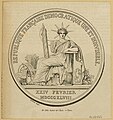Radiate crown
Sassanian Empire (late 3rd century AD, Ctesiphon
mint)A radiant or radiate crown, also known as a solar crown, sun crown, Eastern crown, or tyrant's crown, is a
crown, wreath, diadem, or other headgear symbolizing the Sun or more generally powers associated with the Sun. Apart from the Ancient Egyptian
form of a disc between two horns, it is shaped with a number of narrowing bands going outwards from the wearer's head, to represent the rays of the Sun. These may be represented either as flat, on the same plane as the circlet of the crown, or rising at right angles to it.
Egyptian
In the iconography of ancient Egypt, the solar crown is taken as a disc framed by the horns of a ram[1][2] or cow. It is worn by deities such as Horus in his solar or hawk-headed form,[3] Hathor, and Isis. It may also be worn by pharaohs.[4]
In
Greco-Bactrian example is depicted at the great stupa of Bharhut.[7] The first ruler of Egypt shown wearing this version of a solar crown was Ptolemy III Euergetes (246–222 BC).[8]
-
Amen-Re, wearing a tall feather crown and sun disk (715–664 BC)
-
Egyptian aegis of Isis wearing solar crown (664–343 BC)
-
Coin of Ptolemy IV Philopator, depicting his deified father Ptolemy III (d. 222 BC)
Solar crown of Helios
-
Coin issued by Alexander, King of Epirus (333–330 BC)
-
Helios wearing the chlamys (Tripoli, 1st century AD)
-
Helios in aRoman sarcophagus, early 3rd century AD
Roman Empire

In the
Holy Nails".[12]
Later use
From the
French republics, and is best known from the Statue of Liberty
(formally Liberty Enlightening the World), a gift from France to the United States of America.
-
Ballet costume worn byLouis XIV of France, playing Apollo, 1653
-
lithograph
-
Liberty Enlightening the World, detail of the Statue of Liberty (1886)
See also
- Crown of justification
- Crown of thorns
- Crowns of Egypt
- Halo
- Horned deity
- Taga in Mandaeism
Notes
- ^ Teissier 1996, p. 185
- ^ Cooney 2012, p. 149
- ^ Teissier 1996, p. 50
- ^ Teissier 1996, p. 122
- ^ Stewart 1993, p. 246
- ^ Stewart 1993, p. 180
- ^ Stewart 1993, p. 180
- ^ Stewart 1993, pp. 142, 246
- ^ Bardill 2012, p. 114
- ^ Stewart 1993, p. 246
- ISBN 0299138542, 9780299138547, google books
- ^ Lavan 2011, p. 459
References
Wikimedia Commons has media related to Radiant crowns.
- Bardill, Jonathan (2012), Constantine, Divine Emperor of the Christian Golden Age, Cambridge University Press
- Cooney, Kathlyn M. (2012), "Apprenticeship and Figures Ostraca from the Ancient Egyptian Village of Deir el-Medina", Archaeology and Apprenticeship: Body Knowledge, Identity, and Communities of Practice, University of Arizona Press
- Lavan, Luke (2011), "Political Talimans? Residual 'Pagan' Statues in Late Antique Public Space", The Archaeology of Late Antique 'Paganism', Brill
- Stewart, Andrew (1993), Faces of Power: Alexander's Image and Hellenistic Politics, University of California Press
- Teissier, Beatrice (1996), Egyptian Iconography on Syro-Palestinian Cylinder Seals of the Middle Bronze Age, Orbis Biblicus et Orientalis Series Archaeologia, vol. 11, Fribourg Switzerland: University Press










